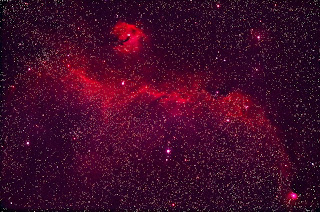This is a new on for me and probably the last of the colorful nebulae for a while as we are moving into galaxy season. I wish the weather would be more in line with galaxy season as well. As this is nebula gives off a strong Ha signal, I collected some Ha data over two nights in addition to collecting the color data. Both nights were good although the first night was an almost full moon. As usual with these Ha-images I stacked it with DSS in super pixel mode and processed it with PS. I did a little noise reduction but not a lot at this point as I want to keep it as sharp and detailed as possible to use when I combine it with the RGB image.
This is the continuation of the Seagull Nebula, I imaged the Ha portion a couple of weeks ago. Again, this probably the last of the colorful nebulae I will be imaging for a while as we are moving into galaxy season. As usual, it takes me forever to process images as I go back and forth with what looks good and what is the object supposed to look like.
The Seagull Nebula or IC 2177 lies along the border between the constellations Monoceros and Canis Major. It lies approximately 3650 ly from Earth and does resemble a bird, at least to me.
The nebula also includes the open clusters NGC 2335 and NGC 2343.
HaRGB Image
RGB Image
Ha Image
IC2177 - Seagull Nebula
Location: Home Monroe, CT
Date: 2-26-18(Ha), 3-11-18 (Ha), 3-5-18 (RGB), 3-11-18 (RGB)
Camera: Canon EOS Rebel T3i(a), Backyard EOS
Telescope: Orion ED80 80mm f/7.5 Apochromatic Refractor Telescope
Barlow: None
Focal Length: 600mm
f/7.5
Focal Reducer: Orion 0.8x Focal Reducer for Refractor Telescopes
Mount: Orion Sirius EQ
Filter: Astrodon UV/IR, Astronomik Ha Clip-filter
Autoguiding: QHY-5L-II-M attached to an Agena 50mm Guide Scope with Helical Focuser
Exposure: 31 x 180s (Ha), 24 x 180 (Ha), 24 x 180s (RGB), 24 x 180 (RGB)
ISO: 1600
Temp: -2 C, 0 C, -2, -6
Post Processing: Deep Sky Stacker, Photoshop, Astronomy Tools, GE, Lightroom.
https://kurtzeppetello.smugmug.com/



No comments:
Post a Comment